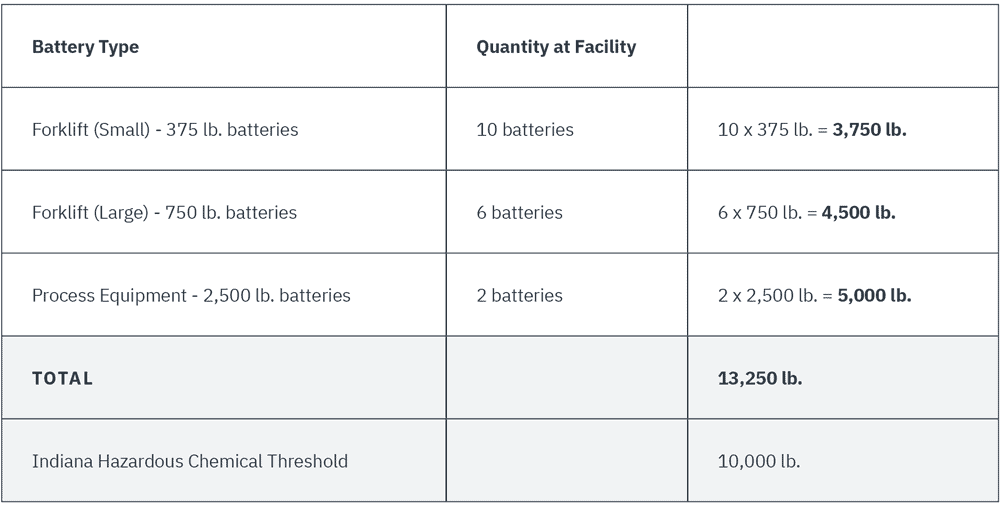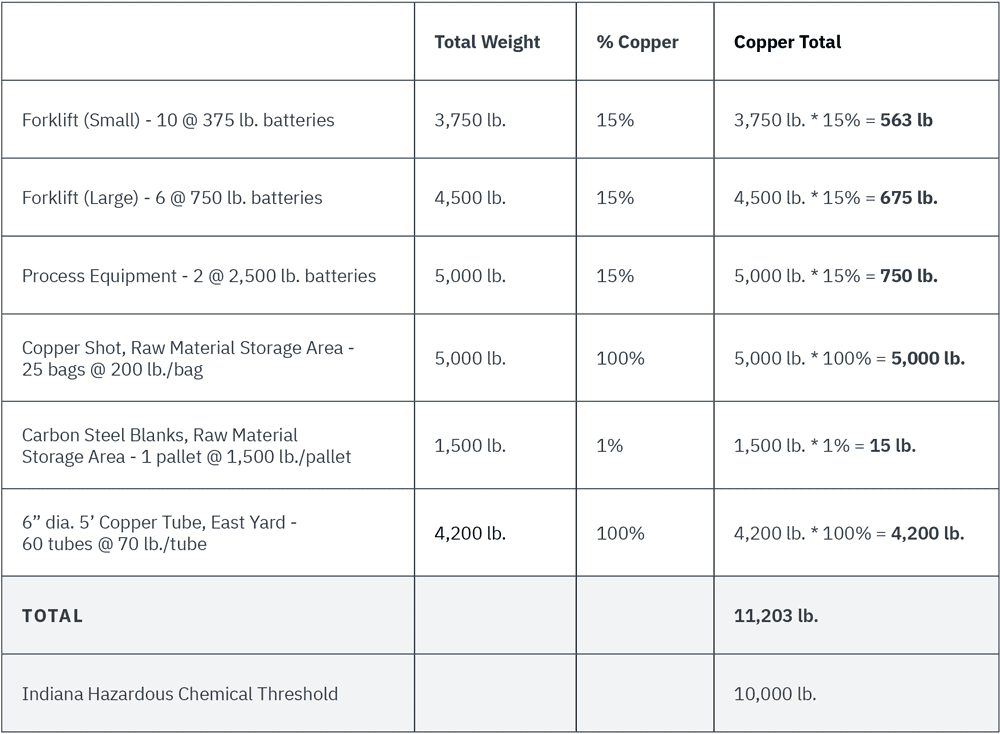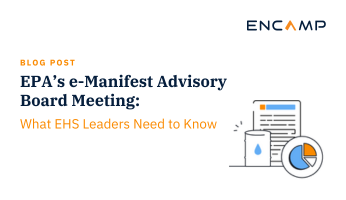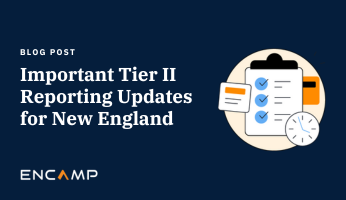No matter what industry they’re in, many businesses have started using lithium-ion batteries as an alternative energy solution to maximize their bottom line, for good reason. Compared to its lead-acid battery counterpart, a lithium-ion battery is 95% more efficient. However, reporting lithium-ion batteries for Tier II continues to raise questions for EHS teams.
Although lithium-ion batteries are sealed, they have the potential to leak flammable chemicals. Due to this, EPCRA requires facilities to complete a Safety Data Sheet (SDS) and Tier II report if the applicable reporting thresholds for batteries on-site are met or exceeded.
3 Common Questions for Lithium-Ion Battery Reporting
Here are three common questions usually asked on whether lithium-ion batteries fall under a facility’s specific Tier II reporting requirements:
-
-
- When is a Tier II report required for lithium-ion batteries?
- What are the Tier II reporting thresholds for these kinds of batteries?
- How does a facility report lithium-ion batteries for Tier II?
1. When is a Tier II report required for lithium-ion batteries?
Some lithium-ion batteries qualify under EPCRA Section 311(e)’s “consumer product exemption,” which excludes from reporting “any substance to the extent it is used for personal, family, or household purposes, or is present in the same form and concentration as a product packaged for distribution and use for the general public.”
When determining whether any lithium-ion batteries at a facility are exempt from Tier II reporting, consider if they’re in the same packaging and concentrations as lithium-ion batteries sold for personal use. If the answer is yes, regardless of whether they’re intended to be distributed for use by the general public or used for the same purpose as a consumer product, then those batteries are exempt.
All other large commercial type lithium-ion batteries stored in a facility are not exempt and should be included in a Tier II report. For example:
Report batteries that are used to power forklifts, because these batteries are not sold for use by the general public.
Report solar batteries of a particular size (approximately 100kWh) that typically have only industrial applications.
Don’t report batteries that the maintenance department uses to power their cordless drills, because these are batteries sold for use by the general public (i.e., the same batteries available for purchase at a hardware store).
Don’t report solar batteries of a particular size (approximately 3 kWh) that consumers would use in their homes.
A gray area exists in what constitutes a lithium-ion battery packaged for distribution and use for the general public. The burden for making this determination is on the facility and they should be able to justify why lithium-ion batteries are exempt.
If you’re in any doubt about whether an exemption applies at a specific facility, be sure to err on the side of caution and report the batteries as a chemical. Doing so will cover the facility from a regulatory compliance perspective, while also increasing safety for first responders and emergency planners. If further guidance is needed, it’s best to reach out to the SERC or LEPC.
2. What are the Tier II reporting thresholds for lithium-ion batteries?
Step 1: Determine the reporting threshold
Because lithium-ion batteries are flammable and present potential safety issues, they’re subject to EPCRA regulations and the reporting thresholds determined for Tier II filing. But unlike lead-acid batteries, lithium-ion batteries do NOT contain any Extremely Hazardous Substances (EHS). Therefore, the reporting threshold for lithium-ion batteries (at the federal level) is 10,000 pounds.
At a state and local level, reporting thresholds are more complex in that they vary among states and even counties and local jurisdictions. While many states have adopted the 10,000-pound reporting threshold for hazardous chemicals, a handful of states have lower Tier II reporting thresholds. This makes it imperative to determine the appropriate requirements for a specific state. For example, Louisiana has a hazardous chemical reporting threshold of just 500 pounds — meaning, having just one lithium-ion battery for a forklift may be enough to require Tier II reporting.
In other cases, specific counties and cities may have even lower reporting thresholds. For example, Gilbert, Arizona has stricter reporting requirements than the state-level.
Step 2: Perform the threshold determination
Now that it’s been determined a Tier II report is needed and what the reporting threshold is, the next step is to quantify the amount of lithium-ion batteries at a facility and make a threshold determination. There are two options available when performing a threshold determination:
Quantifying as Mixture
-
- Calculate the total quantity of lithium-ion batteries present throughout the facility at any one time.
- Report the batteries as a mixture (e.g., “Lithium-ion Batteries”)
Quantifying by Component
-
- Calculate the total quantity of each lithium-ion battery component (e.g., lithium cathode, copper, lead, etc.) present in all mixtures (even in non-lithium-ion batteries) and in all other quantities of the hazardous chemical.
- Report the components individually (e.g., “Copper”), and aggregate the quantities, hazards, and locations across substances into one chemical entry.
In nearly every situation, it’s more appropriate to perform a threshold determination using Option 1, for these reasons:
-
- It’s easier to perform the threshold determination (see some examples below),
- Information presented in this manner is more useful to first responders, and
- Safety Data Sheets (SDSs) are typically published for the batteries as a whole and not the individual components of the batteries. (Such SDSs are also often referred to as a lithium-ion battery SDS.)
If a facility has previously fulfilled obligations for EPCRA Section 311 (SDS reporting) by reporting their lithium-ion batteries as a mixture, the same should be done on the facility’s Tier II report. The opposite is also true — if it’s previously reported as components on the Section 311 reporting, then the facility must do the same on its Tier II report.
To illustrate the difference in complexity between these two approaches, consider the following examples for the same facility (based on requirements in the State of Indiana).
Example 1. Quantifying as a mixture for the state of Indiana

13,250 lb. > 10,000 lb. threshold – Lithium-ion batteries need to be reported at this facility.
Example 2. Quantifying by battery component (copper) for the state of Indiana

11,338 lb. > 10,000 lb. threshold – Copper would need to be reported at the facility.
Note: The exercise in Example 2, quantifying by battery component, would need to be repeated for each constituent in the batteries (lithium-cathode, lead, etc.).
If the threshold is being determined using threshold Option 1, quantifying as a mixture, the following information is needed:
-
- The number of lithium-ion batteries at a facility,
- The weight (or estimated weight) of each lithium-ion battery at a facility, and
- The hazardous chemical reporting threshold for the area in which a facility is located
As shown in Option 1, all that’s needed is to add up the total weight of the lithium-ion batteries and compare the weight to the hazardous chemical reporting threshold.
3. How does a facility report lithium-ion batteries for Tier II?
Now that the quantity of reportable batteries has been confirmed, and it’s been determined that it exceeds applicable thresholds, the last step is creating a Tier II report. Here, we discuss the individual sections that need to be completed. Note: Where examples are provided, the data and scenario from Example 1 are used.
Chemical details in a Tier II submission
Although the Tier II reporting portal interface will vary depending on the state, the following will be true when reporting lithium-ion batteries:
-
- If quantifying as a mixture, “Mixture” should be checked; the CAS Number should be blank or “N/A”, as it is not required for mixtures
- “EHS” should be marked as “No”
- Physical State will be “Solid”
- Because the mixture does not contain any EHSs, the “Mixture Components” section is not required to be filled in. However, it’s recommended to complete this section as a best practice.
- Components can be found in Section 3 of an SDS. When given a range for a component, such as 5-10%, we recommend reporting the higher end of the range (e.g., 10%).
Physical and health hazards
Most lithium-ion batteries will have similar hazards, but it is very important to reference the lithium-ion battery SDS from the manufacturer specific to the batteries at a facility. This way, first responders and emergency planners will be working with the most accurate information. Hazards can typically be found in Section 2 of your SDS.
Typical hazards as they are reported on a Tier II report may be:
Physical hazards:
-
-
- Explosive
- Flammable
- Self-heating
Health hazards:
-
-
- Acute toxicity (any route of exposure)
- Skin corrosion or irritation
- Serious eye damage or eye irritation
- Respiratory or skin sensitization
- Carcinogenicity
- Specific target organ toxicity (single or repeated exposure)
Storage locations
Lithium-ion battery storage locations will consistently be reported with the following properties:
-
- Container Type: Battery
- Pressure: Ambient Pressure
- Temperature: Ambient Temperature
Frequently Asked Questions
I have different SDSs for different types of lithium-ion batteries at my facility. Should I consider them different mixtures, each with their own reporting threshold?
Generally no. While it is ultimately up to the facility to use professional judgment to determine whether the amounts of two mixtures (e.g., two batteries from two separate manufacturers) should be aggregated or counted separately, most lithium-ion batteries present the same physical or health hazards and should be aggregated for threshold determinations.
How do I determine the weight of my lithium-ion batteries?
First, determine the manufacturer and model number of the battery. Most manufacturers post specifications (including weight) on their website for the various lithium-ion battery models they sell. If the weight specification of a particular battery model is unavailable, contact the manufacturer directly.
Reporting lithium-ion batteries on a Tier II report is critical
Again, even though lithium-ion batteries are sealed, they can leak or spill and cause potential exposure to hazardous chemicals. Their flammability also presents safety concerns for local emergency agencies as well as fire departments and first responders. Reporting lithium-ion batteries on a Tier II report therefore is critical. This guide helps facilities ensure their report is accurate. Do you have further questions about reporting lithium-ion batteries? Reach out and learn how Encamp can simplify environmental compliance data and reporting for you.
Transforming the way enterprises stay in compliance
Encamp is on a mission to create a world where good for business can equal good for the environment. We help enterprises transform compliance programs and human processes into a technology-driven system that lays the foundation for accurate and ongoing environmental compliance through a blended method of intelligent high-tech solutions and high-touch expert support.
Eugene Simonds
Eugene Simonds is a Compliance Program Manager at Encamp and a former Environmental Engineer. In his previous role as a consultant, he specialized in multimedia environmental compliance across a broad range of clients and industries. A licensed Professional Engineer (PE) and certified RCRA/DOT/HAZWOPER, his passion is simplifying the environmental compliance experience for everyone.





